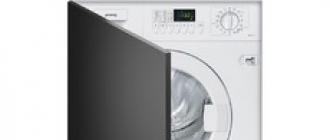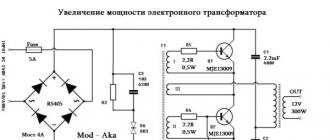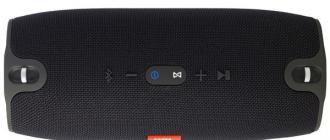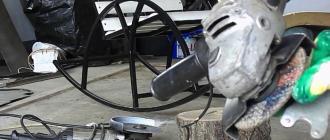Various mechanisms make our work easier, both in production and in domestic conditions. But sometimes they bring unexpected and not very pleasant "surprises". After all, it is impossible to foresee all the situations in which you will have to use the tools.
This also applies to the grinder (angle grinder), when the cutting disc is clamped on it so much that it is not possible to unscrew the clamping nut with a standard wrench or other tools or methods. In this case, there is a risk of breakage of the quick clamping button of the disk and even the body of the tool, usually made of aluminum alloy. The matter is further complicated by the fact that the surface against which the working disk is pressed is often round and it is impossible to stop it.
Why is the lock nut tightening?
The grinder, depending on the brand and the diameter of the working disc, develops from 6,000 to 12,000 revolutions per minute. When the rotating disc touches the surface to be treated, the following rapid processes take place.The cutting disc, cutting into the material, experiences great resistance and slows down somewhat, but the rotor of the electric motor rotates for a few more moments by inertia at the same speed and literally twists the spindle thread into the lock nut, pressing it into the cutting wheel. Now it will not be easy to unscrew it, especially with a native key.

There are various ways to get rid of this defect. Not all of them pass without leaving a trace for the instrument. Here we will consider one of them, which can be called auto thermal.
How to eliminate the disc clamp on the grinder
To implement this method, you will need some kind of massive wooden material: a piece of thick board, a piece of timber, or just a stump.
Then we take a grinder with a tightly clamped disc, turn on the tool and press the fixing nut with sufficient force to the surface of the stump so that it continuously rubbed against the wooden surface.

The process must be continued for two to three minutes. This time is quite enough for the clamping nut not only to heat up, but to glow hot. If the heating is not stopped in time, there is a risk of damage to the spindle bearing due to overheating.

The degree of sufficiency of the thermal effect on the fixing nut can be checked using a pipette filled with water: drops from it instantly evaporate, barely reaching its surface.

Then we proceed in the standard way. Press the button for quick disk replacement and unscrew the nut with a standard wrench without any effort. In this case, the well-known property of the metal helps us to expand when heated.

The nut can be unscrewed absolutely effortlessly.

The disc should be installed on the spindle with the pattern (marking) outward (towards the clamping nut), since it is on this side that the disc has a wide metal washer. If the disc is jammed or broken, the movable clamp will be easier to handle as it will slide over the metal washer rather than the rough surface of the disc.
It helps to put a washer of cardboard or other not too hard material under the nut. But this method is not stipulated by the manufacturer of the tool, since this may disturb the balancing and the reliability of fastening the disk to the spindle is not guaranteed.
Use a blowtorch or gas torch to heat the retainer nut. The heat source in this case does not matter. The main thing is not to overdo it with heating, so as not to damage the spindle bearing.
Angle grinder is a universal power tool. It can be used to cut steel profiles and wood, process concrete and stones, perform grinding and roughing work, sharpen hacksaws. And for each operation a certain circle is provided. For example, you cannot grind surfaces with a thin cutting wheel for a grinder - it will quickly break. How to put the disc on the grinder correctly when grinding and breaking a circle or switching to another type of work?
According to the instruction manual, replacing the disc on the grinder should be done as follows.
- Unplug the power tool cord from the socket.
- Press the spindle rotation lock button.
- While holding the grinder's stopper button, unscrew the flange nut using an open-end wrench. Turn the key for angle grinder in the direction of rotation of the disc. If it is difficult to press the button with one hand and use the key with the other, ask someone close to you to help you.
- Remove the old disc from the spindle shaft.
- Install a new disk.
- Fasten it with a nut by hand or using the same universal wrench. At this moment, you need to hold the stopper with the other hand. Do not overtighten the nut.
- Turn on the grinder in the network for 30 seconds at maximum speed. If the disc rotates freely, without beating, without touching the protective casing, you can start working.
 An open-end wrench must be included in the delivery set of the angle grinder. A poor quality key often goes to cheap grinders. It can quickly break (however, this also happens with tools from leading manufacturers). In the end, the key can simply be lost .
How to properly install the disc on the grinder in this case, without having a suitable tool at hand?
An open-end wrench must be included in the delivery set of the angle grinder. A poor quality key often goes to cheap grinders. It can quickly break (however, this also happens with tools from leading manufacturers). In the end, the key can simply be lost .
How to properly install the disc on the grinder in this case, without having a suitable tool at hand?
The safest way is to simply buy a new key. You can take a standard one, for a specific flange for angle grinders, or sliding, with the ability to adjust the jaws. But the keys for grinders are not sold in all hardware stores, and finding the right tool can be difficult. We bring to your attention a few tricks with which you can change the disc on the grinder without a universal key and save your nerves and money.
How to change a disc on a grinder without a key?
Method 1. Use the gas key. Grasp the nut with an adjustable pipe wrench and loosen it carefully, without applying great force. Disadvantage: you can crush the nut, break the rotation lock.
Method 2. Make a homemade key for the grinder. To do this, you need a long nail (at least 100 mm). It is necessary to cut off the cap, the point and give the nail a U-shape. It should be bent in such a way that the “tool” stands fall into the holes of the flange. If the nut is tightened tightly, insert any metal bar between the posts of the nail and, grasping it with both hands, rotate the structure in the direction of the circle's movement. At this time, you need to press and hold the spindle lock button. The method is safe, but it takes time and additional tools - a hacksaw, a vice, a hammer.
Method 3. Tapping with a chisel. Before changing the disc, you can treat the spindle shaft with WD-40 fluid and wait at least 15 minutes. Then put the tip of a thin chisel at an angle to the hole of the flange nut and gently tap it over the entire surface of the hole with a metal hammer. Sooner or later, thanks to gentle tapping, the nut will slip off, and it will be possible to unscrew it manually. The disadvantage of this method is that you can damage the holes and spoil the flange.
Method 4. Heat the nut. If it is difficult to unscrew the nut of the angle grinder by hand, you can heat it up a little with a gas burner or autogenous gun. Unscrew the flange with gloves so as not to burn yourself. This is the most risky of the proposed methods. It is possible to overheat the bearings and oil in the angle grinder gearbox.
Finally, I would like to mention several important points regarding replacing a disc on a grinder.

The main thing is that when changing a disc on a grinder, do not violate safety precautions and perform all manipulations with the tool turned off from the network.
The angle grinder is a multifunctional but capricious tool that does not tolerate haste and negligence. Breakdowns and breakdowns are the result of careless handling or safety violations. And the most common problem when working with a grinder is jamming of the abrasive tool between the support flange and the clamping nut. How to unscrew the disc on the grinder without damaging the parts and the tool itself?
With open-end wrench and socket head
Grind the working surface of the 17 key to 4 mm in thickness. On the surface of the 24 mm socket, grind 4 projections so that they fit into the holes in the flange.
The open-end wrench must be placed under the disc. Put the socket head on the nut of the grinder and turn it with a ratchet in the direction of rotation of the circle.
Warming up
The clamping nut must be heated with a hot air gun or gas burner to make the metal more pliable. Then unscrew it with the universal wrench or by hand. But the risk of this method is that you can spoil plastic parts and gearbox elements.
 With a gas wrench
With a gas wrench
The shoulder when using the gas wrench increases, therefore, the moment of force also increases. It is easier to unscrew stuck joints with such a tool. But if you try too hard, you risk crushing the flange or breaking the spindle rotation lock.
With a hammer drill in jackhammer mode
The hammer drill must be switched to the chiseling mode without rotation. A 6 mm drill must be placed on the end of the flange or rest against the edge of the hole. The task is to unscrew the nut, to move it from its place. After that, unscrew it with your hands or with a key. During work, you need to block the rotation of the spindle.
Disk destruction
Before unscrewing the nut on the grinder, you will have to completely crumble the disc. If it is already destroyed, you can break it with your hands. Solid circles can be sawn with a hacksaw or a metal blade. The inner metal ring and pieces that do not lend themselves to mechanical stress should remain from the abrasive wheel. Then you need to clamp a metal profile or any unnecessary plate in a vice, the thickness of which is less than or equal to the thickness of the disk (but not more). Then turn on the grinder and grind off the remaining abrasive to the seat sleeve. After that, the flange can be easily unscrewed with a universal key for angle grinders.
You can take care in advance that the tool does not jam in the grinder:

The clamping nut for the grinder is included in the delivery. And the most radical solution for freeing a jammed disc is to saw it and put a new one. You can find these fasteners at all power tool stores.
LBM, or as it is called more popularly and in the folk way, the Bulgarian, nowadays an indispensable and very useful tool. Without him, neither here nor there! And if it suddenly fails, then you have to dodge in every possible way, look for alternatives and think about restoring the instrument. At the same time, it is impossible to use the grinder for its intended purpose because of what seems to be a simple overlay, when the disc does not unscrew. Rather, the nut that holds this disc is not unscrewed. Here you can "break the wood", namely, bend or break the key, damage the lock button, break the case, but never unscrew that same unfortunate nut. So, we will warn you right away, if it is not too late ... If you suddenly do not unscrew the nut holding the disc with a key, then you need to change tactics. And it is precisely the cardinal method of unscrewing that our article will be devoted.
Why bites the nut on the grinder that holds the disc
I will say, perhaps, a well-known truth. He bites nuts more often on grinders with a disc size of a significant size, say 150-180 mm or more. The thing is that the resulting torque, in the case of a disk impact at the time of the start of cutting, is much greater than for a disk, say 125 mm. As a result, the nut is tightened by inertia so much that it is very difficult to break it in the usual and usual ways. Now about the special methods.
How to unscrew the nut of the grinder disk (angle grinder) if it is bitten
So, if there is no way with the key, even if you insert it and hit it slightly with a hammer, then we begin to use something more serious.
The first thing you can try, but again without fanaticism, is to take a rod, insert it into the holes on the nut and, using a hammer, move the nut in the direction of its untwisting. The main thing here is not to break the button and not to rip the holes, as here

The second thing that many advise is to warm the nut. We warm up the nut. As a result, it is slightly, but physically still obliged to expand. Resizing may or may not help ...
Do not pull all the way until the scroll hold button stopper or the button itself bursts. In this case, it is not the tool with which you unscrew it that breaks, but often the case of the angle grinder.
The third method is the most effective, and oddly enough, one of the safest for the grinder itself.
We take and break off the edges of the disc along the nut.

Next, we use a thin metal plate or another disc (thinner), and maybe a second grinder with a disc. In this case, a broken disc must be turned either with a plate or a disc. We try to sharpen the disc so as not to damage the nuts holding this disc, because they will still be useful to us. So we sharpen the whole broken circle until we grind it off and the nut is unscrewed.


This business is 4-5 minutes, no more.

If you will be using a second disc or metal plate, it is best to insert them in a vise to hold them. Since it is dangerous to hold such objects with your hands. This is the most effective method!
How to make sure that you do not bite the nut and disc on the grinder
And a few words about preventing such unpleasant precedents again. You can use small cardboard spacers by inserting them between the disc and the nut. As a last resort, we use a disc with a smaller diameter, unless, of course, the nut is tightened from above. As a result, it will be possible to unscrew such a nut without any problems. It will not be squeezed, for a bite on the thread ...


And another small video on a topic, about a problem that I studied on my own experience.
An angle grinder (angle grinder) or grinder has established itself as a very effective tool with which you can perform a wide range of work. However, during its operation, you should adhere to safety precautions, since the speed of the discs is very high and you can get injured. Judging by the numerous reviews, many home craftsmen have problems with disks, they often crack, and the nuts with which they are clamped bite. The reason for this may be a human factor or simply marriage. As a result, it is impossible to use such a nozzle for its intended purpose.
It would seem that there is nothing difficult in replacing the disk with a new one. Nevertheless, at this stage, the master is faced with a problem - the nozzle is tightly clamped with a fixing nut that does not want to loosen. How to remove a jammed disc from a grinder? What methods are used for this? What tools can be used if the original key is lost? You will learn how to remove a clamped disc from a grinder from this article.
What is the cause of the malfunction?
Before wondering how to remove a disc from a grinder, experts recommend figuring out why it bites a nut on a grinder. It is noticed that this problem is mainly observed in angle grinders, which have a significant disk size. A disc over 18 cm is considered large. During operation, a torque is generated. Further, when the master starts cutting, a small bump occurs. In other words, a force is exerted on the disk. If the size of the nozzle is not more than 12 cm, then this effect will be negligible. If the disc is large, then the nut is tightened by inertia more. As a result, it is not possible to dismantle it in the usual way. More information on how to remove the disc from the grinder is described below.
The first way
How to remove a disc from a grinder if it is broken and tightly clamped with a clamping nut? Of course, you can try using a special key for angle grinders or gas. However, judging by the reviews, having made tremendous efforts and wasting time, the master may not get the expected result. Dismantling can be easier and faster. To do this, you need to completely break the disc with pliers. Due to the fact that small fragments will fly apart during the work, the master will need protective glasses (mask) and gloves.

Then you need to take a metal plate, the thickness of which is less than that of the disc. With the help of this plate, its remnants will be grinded. To do this, you need to turn on the grinder, and clamp the metal piece securely with pliers. After completing these steps, the nut can be unscrewed even by hand.

If the special key that is attached to the angle grinder is not lost, then it will be easier to cope with the task. For those who are interested in how to remove a disc from a grinder, experts advise first of all to fix the spindle. It is on it that the disc is located and is pressed with a flange. It is dismantled with an open-end wrench. To make this technically possible, the flanges are equipped with special holes into which the pins of the key are inserted.

To fix the spindle, you need to press the button, which is located on the housing on the back of the disc. During operation with an open-end wrench, the lock must not be released, otherwise the spindle will continue to turn. If the disc in the grinder rotates clockwise, the open-end wrench should be turned counterclockwise and vice versa. It is important that the flange yields and moves. Now it can be completely unscrewed and set aside. Then the old disc is removed and replaced with a new one.
How to remove without a key?
The grinder's disk, judging by numerous reviews, can be dismantled using a large pipe wrench, which is popularly called a gas wrench. The master first of all needs to dilute it so that it can completely encircle the flange with it. While turning the gas wrench with the flange clamped in it, the spindle is held by some metal object. According to the reviews of home craftsmen, this method is considered very effective. If it did not help, then experts advise "tapping" the nut with a metal bar or a thin chisel. The spindle is also locked in this case. The nut will move if you tap the flange lightly at the very edge. The blows should be carried out in the direction in which the disc is spinning. According to experienced masters, this method cannot be called safe. The fact is that you can damage the flange, namely the holes into which the pins of the open-end wrench are inserted.
Dismantling with a nail
Removing a damaged disc will be easy with a key made from a nail. According to experts, its optimal size is at least 100 mm. First, the nail must be bent into a U-shape. It is important that the distance between its ends matches the two holes in the flange. Then, using a hacksaw from "weaving", you need to carefully cut off the cap and the tip. Now the homemade wrench can be inserted into the flange, fix the spindle and unscrew the mount. If it so happens that the nut is tightened very tightly, you will need a larger lever. It is necessary to insert another "weaving" between the two vertical ends.
What else can you do?
If the above methods do not work, then the nut will have to be heated with a gas burner. Under the influence of high temperature, the nut will expand and begin to turn. You can also use a rather barbaric method, namely, sawing the nut with a hacksaw. Then you have to buy a new one. Some craftsmen use WD-40 penetrating grease. It is used for machining threaded connections. Judging by the reviews, after a few minutes the nut can be scrolled.

Finally
Although many methods have been invented to solve the jammed nut problem, it is best to prevent breakage. Many craftsmen independently equip angle grinders with washers. For the manufacture of such gaskets, cardboard or tin is suitable.






